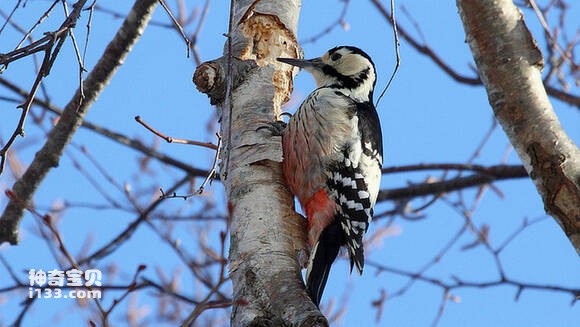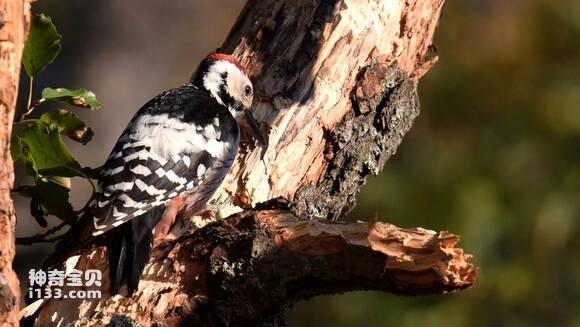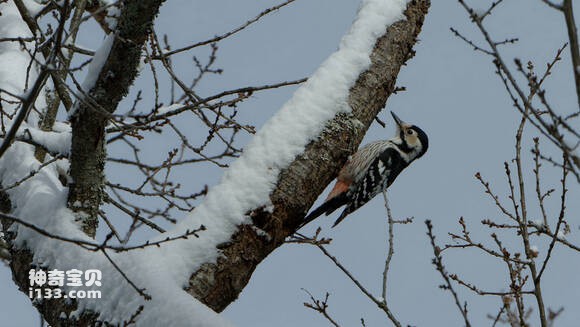Dendrocopos leucotos
IUCN
LCBasic Information
Scientific classification
- name:Dendrocopos leucotos
- Scientific Name:Dendrocopos leucotos,White-backed Woodpecker
- Outline:Climbing birds
- Family:
Vital signs
- length:22-27cm
- Weight:85-117g
- lifetime:No textual research information is available
Feature
Distribution and Habitat
It is distributed in Albania, Armenia, Austria, Azerbaijan, Belarus, Bosnia and Herzegovina, Bulgaria, China, Croatia, Czech Republic, Estonia, Finland, France, Georgia, Germany, Greece, Hungary, Italy, Japan, Kazakhstan, Democratic People's Republic of Korea, Republic of Korea, Latvia, and the Republic of Korea Juttenstein, Lithuania, Macedonia, Moldova, Mongolia, Montenegro, Norway, Poland, Romania, Serbia, Slovakia, Slovenia, Spain, Sweden, Switzerland, Turkey, Ukraine
Travellers: Belgium, Holland.
It is not distributed continuously in China, but is quite common in the region. The named subspecies is distributed in northeast China, extreme northern Xinjiang, Hebei and southeast Inner Mongolia. The Fujian subspecies is found in Wuyi Mountain in northwest Fujian Province and Guanshan Mountain in north Jiangxi Province. Sichuan subspecies is found in Qinling Mountains from southern Shaanxi to central Sichuan. The Taiwan subspecies is native to Taiwan.
It mainly inhabits d
Appearance
The male of the white-backed woodpecker has black nose feathers mixed with brown and white. Forehead brown white, head to pillow red; Eye first, cheek and ear coverts brown white. Black at the front and white at the back above the eyes; Black cheek stripe, extending back to the side of the neck. The upper back of the neck is black, the lower back and waist are white, and the tail is covered with black feathers. Central tail feathers black. The shaft of the feather is bright. Lateral tail feathers white with black markings. Shoulder black, with white end spots; The small cover feathers on the wings are black, the flight feathers are black, and the inner and outer parts have white transverse spots and white end spots; Chin, throat pure white, upper thorax sides black, foreneck and thorax gray white with black plume; The abdomen and flanks are colored with black plumage. Underbelly and undertail coverts are vermilion red. Axillary and underwing coverts white.
The top of the female bird
Details
The White-backed Woodpecker, Dendrocopos leucotos, has 10 subspecies。

White-backed woodpeckers often live alone or in pairs. Family groups of 4-5 birds are seen only for a short time after the young leave the nest. Often climb along the tree trunk from the bottom up to feed, once found in the rotten wood pests peck non-stop, until it is eaten up before flying from tree to tree, flying in waves. Sometimes they feed on ground stumps, roots, or mounds. In winter, when food is poor, the range of activities is large, and sometimes even into the jungle and fences and timber piles near the settlement to forage. The call is a soft gagai, like the alarm sound of a blackbird. Chisel the wood vigorously for about 1.7 seconds and then suddenly accelerate, reducing somewhat at the end.

White-backed woodpeckers feed mainly on a variety of insects such as longicorn adults and larvae, coleoptera insects, kowtovers, ants, silverfish, gilding insects, aphids, pine caterpillars and eggs. They also eat spiders, worms and other small invertebrates. Autumn and winter also eat some acorns, pine nuts, plum and other plant fruits and seeds。

The breeding season of the white-backed woodpecker is from April to June. Mating and courtship begin at the end of March, when the male and female birds first fly together, chase each other through the canopy, fly up and down, and call as they fly. gagaga-gagaga; Constant repetition and continuous tweeting for a long time. After a flight and chase, the male and female birds stand on the thick branches of the tree, a few centimeters to tens of centimeters apart from each other, looking at each other, after a period of time, they gagaga, change positions with each other, and then stand still, looking at each other, so many times or even 10 times before mating. When mating, the male bird mounts on the female bird's back, the head and neck are stretched forward, and the two tails are opposite each other. After about 2-3 seconds, the male and female birds separate, gagaga together and shake their feathers separately. 1-2 minutes later, the chase again and repeat the above process, again mating. Then they both flew deeper into the woods. They usually spend time together. They're not far apart when they're looking for food.
In late April, they began to dig holes and build nests. White-backed woodpeckers never use old nests. New holes are usually pecked every year. Sometimes a hole is found and then discarded, and a new hole is pecked. Generally choose more heartwood decay, easy to peck chisel broadleaf tree nest. The hole is pecked by male and female birds in turn. It takes about 4-10 days to peck. The opening of the nest hole is circular. The diameter of the opening is 5-7 cm. The inner diameter of the hole is 10-13 cm, and the depth of the hole is 19-38 cm. The hole is 4-15 meters above the ground. The hole was lined with tree chips and tree bast. Each clutch lays 3-6 eggs. Oval white, smooth without spots. The size is 26-30 x 19-22 mm, average 28-20.5 mm, and weighs 6.9 grams. The male and female incubate the eggs in turn. Incubation period is 16-17 days. Young birds are late sex. Both male and female birds raise chicks together, and the chicks can leave the nest after about 23-24 days of feeding.
Listed on the International Union for Conservation of Nature (IUCN) 2012 Red List of Threatened Species ver 3.1 - Not Threatened (LC).
It was included in the List of Beneficial Terrestrial Wildlife under State Protection or of Important economic and scientific research Value issued by the State Forestry Administration of China on August 1, 2000.
Protect wild animals and eliminate wild meat.
Maintaining ecological balance is everyone's responsibility!








